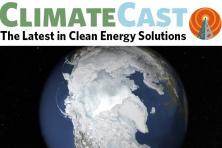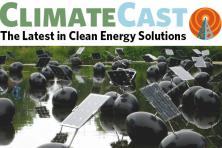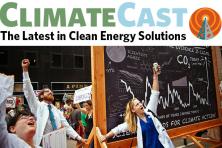The climate crisis and the immigration crisis are more connected than you think
With thousands of families being forcibly separated at the U.S. border, a New York Times opinion piece points to climate change as one of the underlying reasons people emigrate from their homes: a “subtle but still profound dimension to the problems they [people] are leaving behind: environmental degradation or climate change.” An agricultural crisis in Central America, brought on by a decade-long cycle of severe drought and rainfall, is a driving force behind mass migration. And in Texas, many of the shelters where small children and babies are being held are located in areas prone to flooding; a disaster declaration has already been issued in one area near shelters. A recent analysis argues that abolishing ICE is good climate policy: “As climate-fueled migration continues to accelerate, immigration policies will determine how the U.S. government navigates the climate crisis. For now, policymakers' playbook is the war on terror, and its tools are the hapless, barbaric institutions created to wage it.”
What Justice Kennedy’s retirement could mean for the climate
Justice Anthony Kennedy has been the swing vote on many environmental issues, and his announcement has many wondering just what his retirement means for the climate. Five like-minded justices could overturn key environmental rulings, like Massachusetts vs. EPA, which compelled the Environmental Protection Agency to regulate greenhouse gases as pollutants under the Clean Air Act. A new justice could also weaken the Clean Air Act, Clean Water Act, Endangered Species Act, and more.
In another surprising political development, Alexandria Ocasio-Cortez beat longtime US Congress member Joe Crowley in the New York primary and is very likely be elected to Congress in the fall. Ocasio-Cortez’s platform calls for the U.S. to run on 100% renewable energy by 2035, going further than any sitting Congress member in addressing the scale of the climate crisis.
Flourishing renewable energy brings new careers, new hope for the future
Wind and solar are projected to account for almost 50 percent of the world’s electricity generation by 2050, as improvements in batteries to store and discharge energy are coupled with significant investments in wind and solar energy. This scenario represents an important advancement, yet accelerating carbon-free solutions are still needed to meet electricity’s part in limiting global temperatures to a level that is safe for the climate.
Atlanta is developing a plan to transition to 100 percent renewable energy, one of the first Southern U.S. cities to be moving toward 100% clean. Here in the Pacific Northwest, more students than ever are enrolling at the Northwest Renewable Energy Institute in Vancouver, Washington, drawn by the growing demand for family wage jobs as wind technicians and solar installers. A solar farm in Medford, Oregon is maximizing renewable energy sites and generating quite the buzz; they have placed 48 beehives in the space around the solar panels, creating the country’s largest “solar apiary” to save pollinators and help local agriculture.
Vehicle electrification accelerates
Electric vehicles are gaining momentum, despite the federal administration’s efforts to stymie the transition. States are creating their own goals for electrifying transportation, and policymakers developing strategies to get more vehicles on the road. Buses, delivery van and garbage truck fleets are electrifying, including a transit agency serving 450,000 residents in southern California that is aiming to transition its 80 bus fleet to 100% electric by the end of this year. Uber recently announced a new pilot program that will incentivize drivers in several cities to use electric vehicles. Abroad, Italy, historically Europe’s most stagnant market for electric vehicle adoption, has a new plan to put one million electric vehicles on the road in the next four years.
Impacts—Getting serious about sea level rise
According to a new study by the Union of Concerned Scientists, one million homes in Florida— 10% of the state’s residential properties—could be at risk this century due to sea level rise. A new book tells stories of people who live near the sea, and details how much of Florida may be wiped off the map because of climate change. Immense rains are increasingly causing flash flooding in the Great Lakes and Atlantic Coast regions, and experts warn the problem is only getting worse. Sea ice is also melting so rapidly in the Arctic Ocean that scientists predict the region will soon be considered just another part of the Atlantic, rather than its own “characteristically icy Arctic sea.” If we fail to act on climate change, some low-lying countries may be flooded past the point of habitability. Startling new graphics of projected Marshall Island sea level rise show how just one to three feet of sea level rise would overwhelm the country.
What the frack
In Michigan, a draft of proposed changes to the state’s school social studies standards would remove references to climate change, along with other proposed changes. GOP senators are challenging funding for a National Science Foundation education program that works to increase climate reporting by meteorologists. President Trump has nominated a former fossil fuel lobbyist to head the Department of Energy’s Energy Efficiency and Renewable Energy office. And finally, the Federal Administration has created new policies that make it more difficult for federal scientists to quickly respond to media requests, a change employees have stated were designed to “quell discourse about climate change."
In brief: Clean energy advocates easily clear hurdle to put measure on WA ballot
On Monday, a broad coalition of organizations with the Yes on 1631 campaign turned in more than 377,000 signatures to the Secretary of State’s office in Olympia, to qualify Initiative 1631 for Washington’s November ballot. Already the oil industry has shown it is likely to spend against the effort. The Secretary of State's office will now spend several weeks verifying those signatures. I-1631 invests in clean energy innovation, local family-wage jobs, and communities historically hit hardest by pollution through a fee against the state’s largest emitters of carbon pollution.





